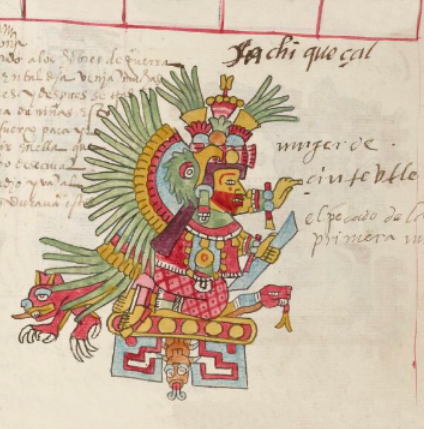Xochiquetzal (TR22v)
This female deity, Xochiquetzal ("Flower Quetzal-Feather") is the counterpart to Xochipilli and has associations with the solar deities or divine forces of the sun. Her name is connoted by the quetzal bird's head that frames her face and the abundant, long, green feathers from the same bird. A large flower bursts up between some green feathers at the top of her head. She holds a weaving batten, which connects to her gender. The batten is emblematic of the fact that she was a patron of spinning, weaving, and embroidery (expressions of a type of graphic expression for women). She also wears an elaborately woven skirt, bracelets with green and turquoise-blue stones. Kneeling is a typical posture for women. Here, she kneels on a stool. A serpent peeks out between the rectangular legs of the stool, and its rattles and protruding, bifurcated tongue are clearly represented.
Stephanie Wood
Xochiquetzal ("Flower Quetzal-Feather") is a patron deity associated with the trecena 19 of the divinatory calendar. [See: Eloise Quiñnones Keber (Codex Telleriano-Remensis, 1995, 187–188) for a discussion about the various ethnohistorical interpretations of Xochiquetzal, some of which are conflicting and confusing.] Xochiquetzal is also a nickname for the xicalpapalotl swallowtail butterfly. [See: Digital Florentine Codex, Book 11, f. 100r., https://florentinecodex.getty.edu/book/11/folio/100r/images/0.]
Stephanie Wood
ca. 1550–1563
Jeff Haskett-Wood
feathers, plumas
xochi(tl), flower, https://nahuatl.wired-humanities.org/content/xochitl
quetzal(li), a quetzal bird feather, https://nahuatl.wired-humanities.org/content/quetzalli
Telleriano-Remensis Codex, folio 22 recto, MS Mexicain 385, Gallica digital collection, https://gallica.bnf.fr/ark:/12148/btv1b8458267s/f70.item.zoom
The non-commercial reuse of images from the Bibliothèque nationale de France is free as long as the user is in compliance with the legislation in force and provides the citation: “Source gallica.bnf.fr / Bibliothèque nationale de France” or “Source gallica.bnf.fr / BnF.”


